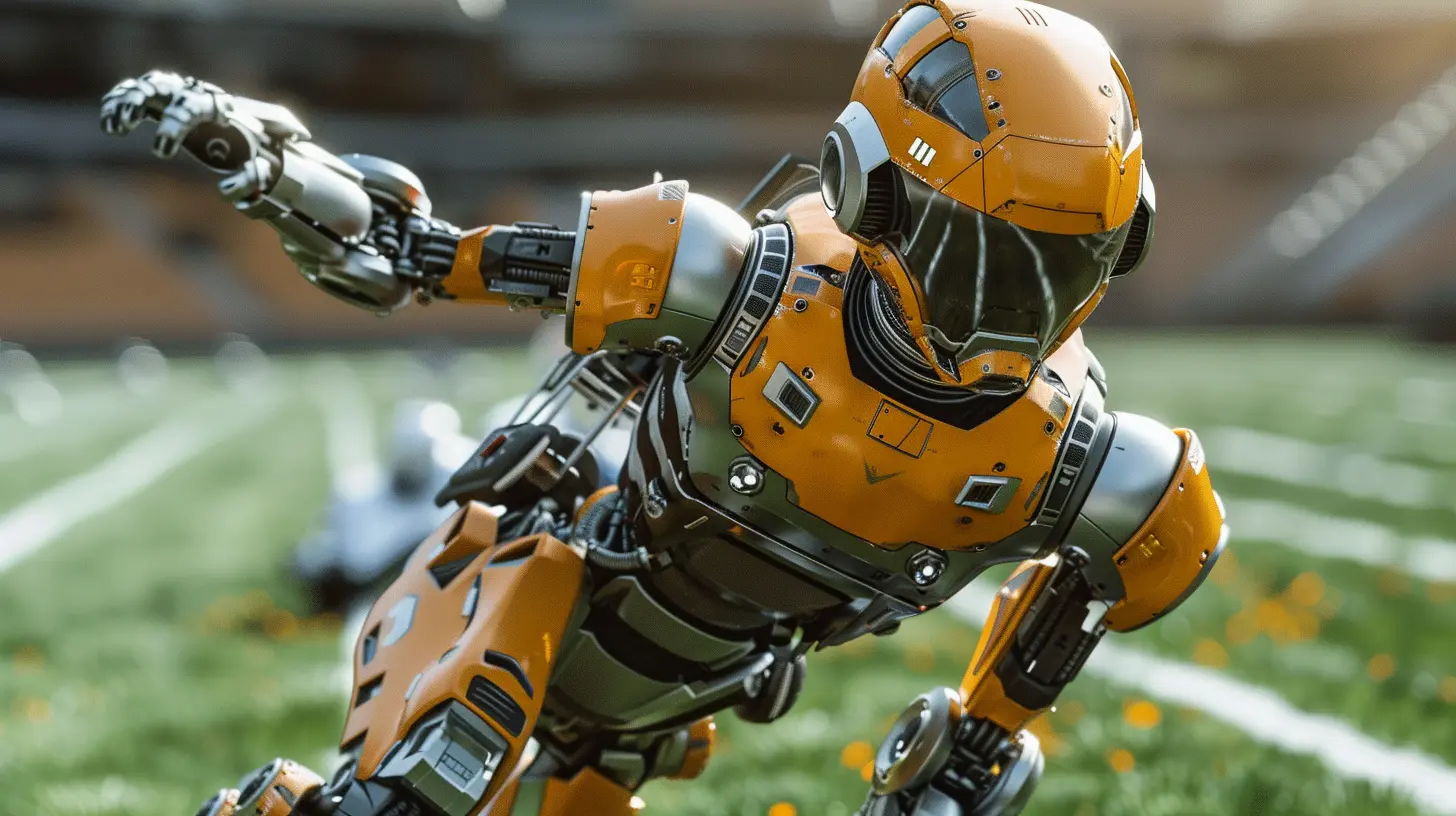How Robotics is Innovating the World of Sports
11 November 2025
Ah, sports. The timeless battle of human strength, speed, and skill. A true test of raw talent! Or, at least, it used to be—until robots started inching their way into the game. Now, instead of humans duking it out on the field, we've got robots analyzing our every move, helping referees make “fair” decisions, and even replacing coaches (because, clearly, humans weren’t already feeling inferior enough).
But hey, who’s complaining? Robotics is revolutionizing the sports industry in ways we never thought possible. So, grab your popcorn and watch as technology takes over yet another aspect of our lives—this time, in the world of sports.

Robotics in Sports: A Game-Changer or Just Showing Off?
Let’s be honest: robots are pretty much the straight-A students of the sports world. They don’t get tired, they don’t break a sweat, and they certainly don’t fumble under pressure. But does that mean they’re ruining the game, or are they actually making it better? Spoiler alert: it’s a mix of both.From improving performance to making sure referees don’t "accidentally" miss a call (looking at you, soccer refs), let’s break down how robotics is changing the way we play, train, and even watch sports. 
1. Robot Referees: Finally, No More Bad Calls (Probably)
If there’s one thing that unites all sports fans, it’s their undeniable ability to criticize referees. Bad calls have been ruining games since—well—forever. Enter robot refs, the emotionless, data-driven officials who (supposedly) eliminate human error.Take VAR (Video Assistant Referee) in soccer. While not a full-fledged robot yet, it uses AI to review plays and determine if a referee’s call was correct. And let’s be real—this has been both a blessing and a curse. Sure, games are now "fairer" (whatever that means), but reviewing every little detail makes the game slower than a dial-up internet connection.
Then there’s Hawk-Eye, a ball-tracking system used in tennis and cricket. This tech ensures that the ball is either in or out—no arguments, no tantrums, no McEnroe-style meltdowns. But let’s face it: it takes away the drama! Where’s the fun if players can’t argue with the umpire for five minutes straight? 
2. Training with Robots: Because Coaches Apparently Weren’t Tough Enough
Think your coach was strict? Try training with an AI-powered robot that doesn’t believe in "off days" or "mercy."Sports teams are increasingly using robotic assistants to fine-tune player performance. These tireless machines can analyze every minor movement and provide instant feedback. No more slacking off during practice, because your robot coach is always watching.
Take Robocoach, for example. It's an AI-driven system that helps athletes perfect their technique by analyzing their biomechanical data. Every sprint, every throw, every jump—all broken down into mathematical perfection. Say goodbye to the good old days of half-hearted practice!
And let’s not forget robotic sparring partners. Boxers and martial artists now train with AI-powered dummies that move, dodge, and hit back (ouch). You can’t even complain about being tired because, well, your opponent is literally a machine. 
3. Injury Prevention: Robots Know Your Body Better Than You Do
Sports injuries are as inevitable as bad WiFi during an important Zoom meeting. But thanks to robotics, we’re inching closer to minimizing those "oops" moments on the field.Wearable robotics like exoskeletons help athletes train harder while reducing injury risks. These futuristic-looking suits provide support to key muscle groups, ensuring that players don’t push themselves to the point of self-destruction (which, let’s be honest, they totally would).
Then we have AI-driven motion analysis tools. These nifty contraptions can track an athlete’s movements and predict potential injuries before they happen. So next time your coach tells you to "walk it off," just show them the robot’s data proving that your knee is about to betray you.
4. AI-Powered Game Strategies: Because Why Trust Humans?
If you thought your coach had an impressive playbook, wait until you see what AI strategists bring to the table.Professional teams are now using AI to analyze past games, study opponent strategies, and generate foolproof game plans. These robotic analysts crunch thousands of data points in seconds—because, you know, humans apparently need "sleep" and "rest breaks."
Take IBM’s Watson, for example. This AI-powered system has been used to analyze player data in basketball, helping teams predict their opponents' next move. Coaches can now strategize with a level of precision that makes human intuition look like a guessing game.
Is this cheating? Maybe. But if everyone’s doing it, does it even count?
5. Spectator Experience: Technology is Stealing the Show
Watching sports has also gotten a major tech upgrade. And no, I'm not just talking about the overly dramatic slow-motion replays.Robotics has given us drones that offer insane aerial views, automated camera systems that track every movement with Jedi-like precision, and AI-powered commentators that (let’s be honest) sometimes sound more excited than the actual humans.
Then there’s virtual reality (VR), which lets fans immerse themselves in the game from the comfort of their couch. Want courtside seats for the NBA Finals? No problem—just strap on a VR headset and boom, you’re there. Except, unlike the guy who paid $5,000 for his ticket, you don’t have to worry about someone spilling beer on you.
6. Robotic Athletes: Because Humans Weren’t Already Feeling Inferior Enough
And now, for the grand finale—actual robotic athletes competing in sports. Because, apparently, humans weren’t enough competition for each other.Take RoboCup, an international tournament where AI-powered soccer-playing robots go head-to-head. Sure, they waddle more than they run, but give them a few years, and they’ll probably be scoring goals that would make Messi jealous.
Then there’s Robot Jockeys in camel racing. Yes, you read that right. In countries like Qatar and UAE, humanoid robots have replaced human jockeys in camel races. Why? Because it turns out tiny human jockeys were, um, problematic. So now, robots do the job—because if there’s one thing robots are great at, it’s following orders without question.
And let’s not forget AI-powered chess bots that can crush even the greatest human minds. Remember when a chess-playing computer named Deep Blue defeated grandmaster Garry Kasparov? Yeah, that was basically the moment we realized AI was coming for us all.
Final Thoughts: Should We Just Let Robots Take Over Sports?
So, here we are—living in a world where robots don’t just assist in sports, they actively participate. Is this the end of good old-fashioned human competition? Probably not. But it’s definitely a sign that sports will never be the same again.On the bright side, at least we won’t have to deal with biased referees and injury-prone athletes anymore. But at the same time, let’s admit it—half the fun of sports is the unpredictability, the drama, and yes, even the human errors.
So, while robots continue to make sports "better," let’s hope they don’t take away all the fun in the process. After all, nobody wants to see a robot doing the victory dance instead of a real, sweaty, overly emotional human. That’s just depressing.
all images in this post were generated using AI tools
Category:
RoboticsAuthor:

Michael Robinson
Discussion
rate this article
1 comments
Daisy Lozano
Robotics is revolutionizing sports through enhanced training, injury prevention, and performance analytics. From advanced wearables that track athletes' biomechanics to robotic referees ensuring fair play, these innovations are not only improving athlete preparation but also reshaping how fans engage with their favorite sports.
November 17, 2025 at 5:29 AM

Michael Robinson
Thank you for highlighting the transformative impact of robotics in sports! It's exciting to see how technology is enhancing both athlete performance and fan experiences.


